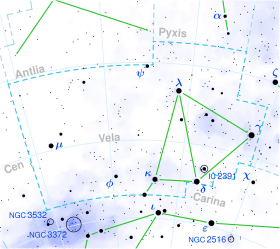| Observation data Epoch J2000.0 Equinox J2000.0 | |
|---|---|
| Constellation | Vela [1] |
| Right ascension | 09h 04m 09.27988s [2] |
| Declination | −47° 05′ 51.8548″ [2] |
| Apparent magnitude (V) | 3.75 [1] |
| Characteristics | |
| Spectral type | K2III [3] |
| B−V color index | +1.174±0.056 [1] |
| Astrometry | |
| Radial velocity (Rv) | +24.3±0.7 [1] km/s |
| Proper motion (μ) | RA: −47.45 [2] mas/yr Dec.: +41.48 [2] mas/yr |
| Parallax (π) | 10.89±0.11 mas [2] |
| Distance | 300 ± 3 ly (91.8 ± 0.9 pc) |
| Absolute magnitude (MV) | −1.06 [1] |
| Details | |
| Radius | 27.32+3.61 −2.54 [4] R☉ |
| Luminosity | 271.5±8.3 [4] L☉ |
| Temperature | 4,483+224 −270 [4] K |
| Other designations | |
| c Vel, CD−46°4883, HD 78004, HIP 44511, HR 3614, SAO 220803 [5] | |
| Database references | |
| SIMBAD | data |
HD 78004 is a single [6] star in the constellation Vela. It has the Bayer designation c Velorum, while HD 78004 is the identifier from the Henry Draper catalogue . The object has an orange hue and is visible to the naked eye with an apparent visual magnitude of 3.75. [1] It is located at a distance of approximately 320 light years from the Sun based on parallax, [2] and is drifting further away with a radial velocity of +24 km/s. [1]
This is an aging K-type giant star with a stellar classification of K2III, [3] having exhausted the supply of hydrogen at its core then cooled and expanded off the main sequence. At present, it has 27 [4] times the radius of the Sun. The star is radiating 271.5 times the luminosity of the Sun from its enlarged photosphere at an effective temperature of 4,483 K. [4]
